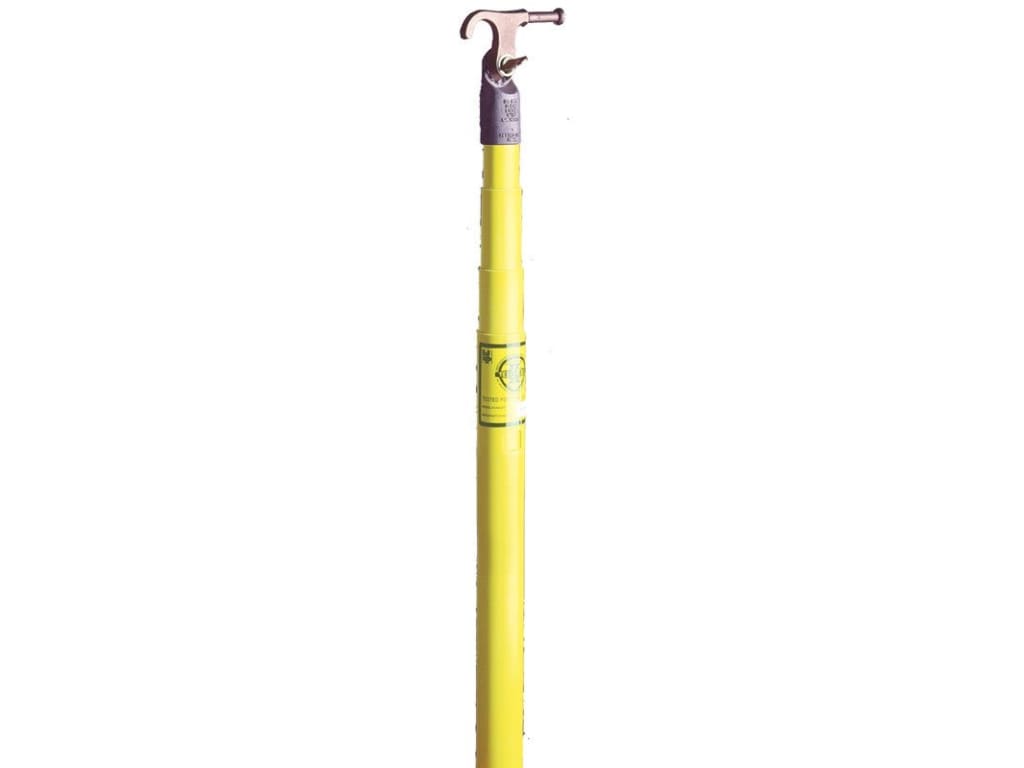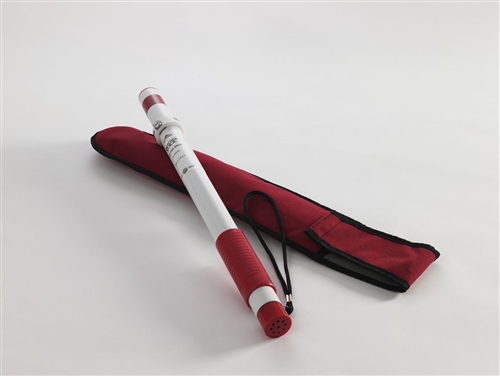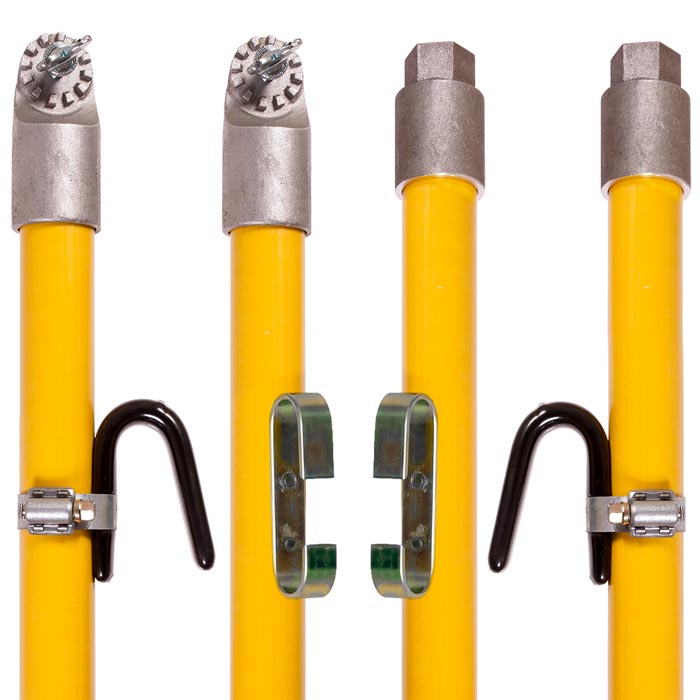Hotsticks are specialized tools used by electrical workers to handle high-voltage equipment safely. They provide insulation and protect workers from electric shocks.
Hotsticks, also known as insulating sticks or live-line tools, are essential for electrical safety. They are designed to allow workers to perform maintenance and repairs on energized electrical equipment. These tools are typically made from fiberglass or other insulating materials.
Hotsticks come in various lengths and configurations to suit different tasks, ensuring that workers can maintain a safe distance from high-voltage lines. Proper use of hotsticks reduces the risk of electrical accidents, making them indispensable in the utility and electrical maintenance industries. Safety protocols and regular training are critical when using these tools to ensure maximum protection.

Credit: www.tequipment.net
Introduction To Hotstick
The Hotstick is a critical tool for electrical safety. It is used by linemen and electricians. This tool helps in handling live electrical wires safely. The Hotstick is insulated and non-conductive. It protects workers from electric shocks and burns.
Purpose And Importance
The main purpose of the Hotstick is safety. It allows workers to handle live wires safely. This tool helps in preventing accidents. It also reduces the risk of electric shock. The Hotstick is essential for any electrical work.
Using a Hotstick is important for several reasons:
- Prevents electric shocks
- Ensures worker safety
- Allows safe handling of live wires
- Reduces workplace accidents
Brief History
The Hotstick has a long history. It was first used in the early 20th century. Electricians needed a safe way to handle live wires. The Hotstick was invented to solve this problem. Over the years, the design has improved. Today, it is a vital tool in the electrical industry.
Here is a brief timeline:
- Early 1900s: First Hotstick invented
- 1950s: Improved insulation materials
- 1980s: Lightweight and durable designs
- Present day: Advanced safety features

Credit: www.mitchellinstrument.com
Types Of Hotsticks
Hotsticks are essential tools for electrical work. They keep workers safe from high voltage. There are different types of hotsticks available. Each type serves a specific purpose. Let’s explore the main types of hotsticks.
Telescopic Hotsticks
Telescopic hotsticks are versatile tools. They can extend to various lengths. This makes them ideal for reaching high places. Telescopic hotsticks have multiple sections. These sections slide into each other for easy storage.
| Feature | Details |
|---|---|
| Material | Fiberglass |
| Length | Up to 40 feet |
| Weight | Lightweight |
- Easy to transport
- Adjustable length
- Durable and strong
Universal Hotsticks
Universal hotsticks are very adaptable. They can be used with various attachments. This makes them suitable for many tasks. Universal hotsticks often feature a universal head. This head can hold different tools securely.
- Highly adaptable
- Compatible with many tools
- Provides a firm grip
| Feature | Details |
|---|---|
| Material | High-strength fiberglass |
| Length | Varies |
| Weight | Medium |
Both types of hotsticks are crucial for safety. They make electrical work safer and more efficient.
Key Features
The Hotstick is an essential tool for electrical professionals. It offers safety and efficiency. Let’s dive into its key features.
Material Composition
The Hotstick is made from high-quality, durable materials. The main material is fiberglass, which provides strength and insulation. It also includes polyurethane foam for added safety. This combination ensures the tool is lightweight and easy to handle.
| Component | Material |
|---|---|
| Shaft | Fiberglass |
| Grip | Rubber |
| Insulation | Polyurethane Foam |
Design Variations
The Hotstick comes in various designs to suit different tasks. There are telescopic models that extend to different lengths. This feature allows for flexibility in reaching distant objects. Some designs include interchangeable heads for different applications. These heads can be switched easily, saving time.
- Telescopic Models
- Interchangeable Heads
- Ergonomic Handles
Each design focuses on user safety and efficiency. The ergonomic handles reduce hand fatigue during long tasks. This ensures a comfortable grip at all times.

Credit: shop.hotstickusa.com
Usage In Different Environments
The Hotstick is a versatile tool used in various settings. It ensures safety and efficiency in both residential and industrial environments. Below are some key applications of the Hotstick in different environments.
Residential Applications
In residential areas, the Hotstick is valuable for several tasks. It helps homeowners and electricians work safely around live electrical wires.
- Tree Trimming: Homeowners use it to trim trees near power lines.
- Electrical Repairs: Electricians rely on it to fix household wiring issues.
- Safety Checks: It aids in inspecting electrical outlets for faults.
These applications make the Hotstick an essential tool for residential safety and maintenance.
Industrial Settings
In industrial environments, the Hotstick is indispensable for various operations. It ensures worker safety and maintains operational efficiency.
- High Voltage Inspections: Used to inspect high voltage equipment without direct contact.
- Maintenance Tasks: Facilitates maintenance work on electrical systems in factories.
- Emergency Situations: Essential for safely handling electrical emergencies.
These applications highlight the importance of the Hotstick in maintaining industrial safety standards.
| Environment | Application | Benefit |
|---|---|---|
| Residential | Tree Trimming | Prevents accidents near power lines |
| Residential | Electrical Repairs | Ensures safe repairs |
| Industrial | High Voltage Inspections | Safety during inspections |
| Industrial | Maintenance Tasks | Efficient maintenance |
The above table summarizes key applications and benefits of the Hotstick in different environments.
Safety Protocols
Ensuring safety while using a hotstick is crucial for electrical workers. Proper protocols help prevent accidents and injuries. Below are essential safety measures to follow.
Inspection Guidelines
Before using a hotstick, always perform a thorough inspection. Look for any cracks, wear, or damage. Ensure the stick is clean and free from contaminants. Follow these steps to inspect your hotstick:
- Visual Inspection: Examine the entire length for any visible damage.
- Check Labels: Ensure all safety labels are intact and readable.
- Flex Test: Gently bend the stick to check for flexibility and resilience.
Maintenance Tips
Regular maintenance keeps your hotstick in top condition. Follow these tips to maintain your equipment:
- Cleaning: Use a mild detergent and water to clean the stick. Avoid abrasive cleaners.
- Storage: Store the hotstick in a dry, cool place. Avoid direct sunlight and moisture.
- Periodic Testing: Conduct dielectric testing periodically to ensure insulation integrity.
| Maintenance Task | Frequency |
|---|---|
| Cleaning | After every use |
| Visual Inspection | Before each use |
| Dielectric Testing | Every 6 months |
Training And Certification
To work with a Hotstick, proper training and certification are crucial. This ensures safety and efficiency. Understanding the necessary qualifications and available training programs is essential for anyone in this field.
Required Qualifications
Before enrolling in a training program, certain qualifications are needed:
- High school diploma or equivalent
- Basic understanding of electrical systems
- Physical fitness and good hand-eye coordination
These qualifications help ensure that trainees can handle the rigorous training and the demands of the job.
Training Programs
Several training programs are available for Hotstick certification. These programs cover various aspects:
| Program | Duration | Content |
|---|---|---|
| Basic Training | 2 weeks | Introduction to Hotstick, basic safety protocols |
| Intermediate Training | 4 weeks | Advanced techniques, emergency procedures |
| Advanced Training | 6 weeks | Complex operations, troubleshooting |
Each program builds on the previous one, ensuring comprehensive knowledge and skills.
Instructors in these programs are experts with years of experience. They provide hands-on training and real-world scenarios. This prepares trainees for any situation they may face in the field.
Common Mistakes
Hotsticks are crucial tools for electrical work. But, many make mistakes using them. These mistakes can be costly or dangerous. Let’s look at common mistakes with hotsticks.
Improper Handling
Improper handling of hotsticks can lead to accidents. Always hold the hotstick firmly. Keep your hands dry to avoid slipping. Never use a hotstick as a lever or pry tool. This can damage it.
When transporting hotsticks, use proper carrying methods. Avoid dragging them on the ground. This can cause wear and tear. Store hotsticks in a dry and safe place. Keep them away from sharp objects. This ensures they stay in good condition.
| Do’s | Don’ts |
|---|---|
| Hold firmly with dry hands | Use as a lever |
| Store in dry places | Drag on the ground |
Neglecting Maintenance
Neglecting maintenance can shorten the hotstick’s life. Regular checks are necessary. Inspect for cracks, bends, or wear. Clean the hotstick after each use. This removes dirt and residue. Use recommended cleaners only. Harsh chemicals can damage the tool.
Keep a maintenance log. Record every inspection and cleaning. This helps track the hotstick’s condition. Replace the hotstick if any damage is found. Using a damaged hotstick is risky.
- Inspect for cracks and bends
- Clean after each use
- Use recommended cleaners
- Keep a maintenance log
- Replace if damaged
Future Innovations
The world of Hotstick is constantly evolving. Future innovations promise to make these tools more efficient and sustainable. Below, we explore the key advancements and initiatives shaping the future of Hotstick technology.
Technological Advancements
Technological advancements in Hotstick are making these tools smarter and safer. One major innovation is the integration of smart sensors. These sensors can detect electrical faults quickly. They alert users immediately, minimizing the risk of accidents. Another advancement is the use of lightweight materials. These materials make Hotsticks easier to handle. They reduce user fatigue during long operations.
Let’s look at some specific technological features:
- Smart sensors for real-time monitoring
- Lightweight composite materials
- Enhanced grip design for better control
- Longer battery life for extended use
Sustainability Initiatives
Sustainability is becoming crucial in Hotstick manufacturing. Companies are focusing on eco-friendly materials. These materials are not only durable but also recyclable. This reduces environmental impact significantly.
Here are some sustainability initiatives:
- Use of recycled plastics in production
- Energy-efficient manufacturing processes
- Durable designs to reduce waste
- Eco-friendly packaging solutions
Future innovations in Hotstick are promising. They are making the tools smarter, safer, and more sustainable.
Frequently Asked Questions
What Is A Hot Stick Used For?
A hot stick is used to safely handle live electrical equipment. It allows workers to maintain distance and avoid electric shocks.
How Does An Ac Hot Stick Work?
An AC hot stick insulates and protects workers from high voltage. It allows safe handling of live electrical equipment. The stick’s non-conductive material prevents electric shock, ensuring safety during maintenance tasks.
What Is The Long Stick Thing With Bristles On The End Used For?
A long stick with bristles on the end is typically a broom. It is used for sweeping floors.
How Often Do Hot Sticks Need To Be Tested?
Hot sticks need testing every year to ensure safety and functionality. Regular testing is crucial for reliable performance.
Conclusion
Embracing the Hotstick can significantly enhance safety and efficiency in electrical maintenance. Its advanced features ensure reliability and ease of use. Whether for professionals or DIY enthusiasts, this tool proves invaluable. Invest in a Hotstick to experience safer and more efficient electrical work.
Make the smart choice today for a safer tomorrow.


